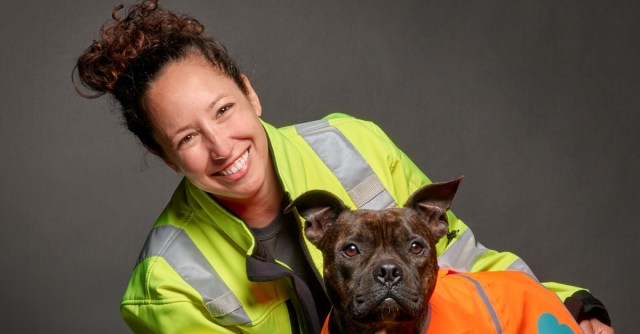One safety expert shows how simple it can be.
Most of us go out of our way to avoid difficult conversations. Just thinking about it can make the heart race and body tighten up. And if avoidance is uncomfortable, it’s also unhealthy.
The stakes of avoidance are even higher in careers like construction, where failing to address safety lapses can have catastrophic outcomes for workers and profits.
Monica Rakoczy has made safety her business. As the owner of EnterTRAINING Solutions, she uses real-life scenarios to engage workers in fleet safety. As a featured speaker at ConExpo this year, she spread her message that safety conversations don’t have to be difficult. Guided by data, they can be downright positive.

The next time you have to have a difficult conversation with an operator, follow Rakoczy’s advice below for the most positive results.
Keep an open mind
For fleets that use AI dash cams, there’s a benefit to the real-time alerts that stop unsafe driving in its tracks. But how can you use AI dash cam footage to coach operators to improve?
Before meeting with the operator, review the footage from the AI dash cam at least twice, then contemplate questions that can help you stay objective. Ask yourself:
- Is unsafe behavior out of character for this operator?
- Why might they have been speeding or following too closely?
- Are they under a lot of pressure?
By assuming the operator has good intentions, your tone will be positive going into the discussion. Coaching conversations don’t have to last long, and for the best results, they shouldn’t.
Make the most of your time by preparing for the discussion beforehand. Review the operator’s safety history for trends. Jot down points you want to discuss. And if you have big concerns, consult a colleague for an unbiased opinion on behaviors shown in the dash cam video.
Make operators feel safe
“If you can’t make team members feel safe in conversation, how can you inspire them to drive safely on the road?” Rakoczy asks. “By putting yourself at ease, you’ll put operators at ease. Relax, soften your tone, and note how the operator softens, too.”
To make the dialogue more positive from the start, approach fleet safety coaching as a mentoring opportunity. “Remember, we’re not safety cops, we’re safety mentors,” Rakoczy says. “We need to get away from thinking of safety as policing and understand that it’s really about coaching. With a more human approach, our discussions will become much more open and productive.”
Use AI dash cam footage to guide the conversation
“Technology is great. Where it has brought us is incredible, but technology is at its best when we use it to enrich relationships,” Rakoczy says.
Dash cam clips generated by AI dash cams can be especially helpful in driving the conversation with your operators. Video captured by dual-facing AI dash cams shows exactly where the operator’s attention was focused when an unsafe event occurred.
Was the operator looking down at their phone? Reaching for something in the vehicle? Discussing these details while watching the video together will keep the conversation focused and impactful. Let the operator tell you what they see in the video.
Having them narrate will make them more aware of their actions in the future. It will also make fleet safety coaching more of a conversation. If an operator is stressed about something, those details should come out in the coaching session, allowing you to build the relationship.
“Use the dash cam clip as a tool to connect on a deeper level,” Rakoczy advises. “You could say, ‘How does seeing that behavior make you feel?’ or ‘Tell me more about that.’ You’ll make the most progress on safety by acknowledging the person behind the job.”
Listen, reflect, observe
Active listening plays a huge role in understanding an operator’s motivation. The better you understand your team, the easier communicating with them will be. Rakoczy encourages coaches to practice the 60:40 rule: Listen 60% of the time, talk 40% of the time.
“The better you listen, the better you can appreciate outside stresses that may be causing the operator to perform unsafely,” she says. “Having that insight will help you address any safety issues more directly and prevent similar incidents from happening.”
Create a positive outcome
If you go into the fleet safety coaching session thinking “this is going to be tough,” it probably will be. Instead, go in believing the coaching session will produce positive results. Focus on immediate and long-term goals the discussion can create for the operator, and have confidence those goals will be achieved.
“When your attention is focused on positive outcomes and benefits, it will shift your thinking process and inner dialogue to a more constructive place,” the Harvard Business Review writes. “As a result, you’ll grow more comfortable approaching the coworker who constantly criticizes and complains, or the subordinate who keeps underperforming.”
Agree on next steps
In closing out the fleet safety coaching session, be clear about what action items you and the operator are agreeing to. Get a firm commitment about next steps and what the operator is responsible for going forward. You could:
- Use statements such as “Just to make sure we’re on the same page” or “Let’s review what we’ve just agreed to.”
- Confirm what the next steps should be.
- End by thanking the operator and letting them know they’re a valuable member of the team.
Allowing the operator to take responsibility for unsafe driving behaviors will make them less likely to repeat the same behaviors going forward. By ending the session with clarity and accountability, you’ll correct any misunderstandings between yourself and the operator.
Read: Motive and Platform Science partner to enhance fleet safety.
Start coaching to see how positive it can be
Ready to take the next step? Download our guide to launching a fleet safety coaching program, then request a demoto get started.










